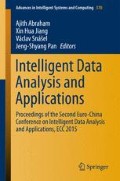Abstract
This paper presents Case-Based Reasoning (CBR) system to asses water pollution based on fish liver histopathology as biomarker. The proposed approach utilizes fish liver microscopic images in order to asses water pollution based on knowledge stored in the case-based database and stores likelihood description of the previous solutions in order to make the knowledge stored more flexible. The proposed case-based reasoning system consists of 5 phases; namely case representation (pre-processing and feature extraction), retrieve, reuse/adapt, revise, and retain phases. After applying pre-processing and feature extraction algorithms on the input images, similarity between the input and case base database is being calculated in order to retrieve similarity. Experimental results show that the performance of CBR systems increases according to the number of retrieved cases in each scenario against each strategy. The proposed system achieved 95.9 \(\%\) accuracy for all water quality degrees.
Access this chapter
Tax calculation will be finalised at checkout
Purchases are for personal use only
References
Tantawi PI, OShaughnessy NJ, Gad KAR, Ragheb MAS (2009) Green consciousness of consumers in a developing country: a study of egyptian consumers. J Contemp Manage Res 5(1): 29–50
Diersing N (2009) Water quality: frequently asked questions. PDA. NOAA. http://floridakeys.noaa.gov/pdfs/wqfaq.pdf, pp 08-24
Johnson DL, Ambrose SH, Bassett TJ, Bowen ML, Crummey DE, Isaacson JS, Johnson DN, Lamb P, Saul M, Winter-Nelson AE (1997) Meanings of environmental terms. J Environ Qual 26:581–589
United States Environmental Protection Agency (EPA) (2006) Washington procedures for review and revision of water quality standards. In: Water quality handbook
Saeed, SM, Shaker IM (2008) Assessment of heavy metals pollution in water and sediments and their effect on Oreochromis Niloticus in the northern Delta lakes, Egypt. In: 8th international symposium on Tilapia in Aquaculture, pp 475–490
Viana AP, Frdou FL, da Silva Montes C, Rocha RM (2012) Heavy metal pollution and metallothionein expression: a survey on egyptian Tilapia Farmsl. Springer, vol 35, no 3, pp 395
Trujillo-Jimnez P, Sedeo JE, Lpez-Lpez E (2014) Assessing the health condition profile in the freshwater fish in Champoton river, Mexico Astyanax aeneus. J Environ Biol 1:137–145
Quesada-Garca A et al (2013) Use of fish farms to assess river contamination: combining biomarker responses, active biomonitoring, and chemical analysis. J Aquat Toxicol 140:439–448
Policastro Claudio A, de Carvalho André CPLF, Delbem Alexandre CB (2004) A hybrid case based reasoning approach for monitoring water quality. In: Orchard Bob, Yang Chunsheng, Ali Moonis (eds) IEA/AIE 2004, vol 3029., LNCS (LNAI)Springer, Heidelberg, pp 492–501
Ani EC, Avramenko Y, Kraslawski A, Agachi P (2009) Sl, “Selection of models for pollutant transport in river reaches using case based reasoning. Comput Aided Chem Eng 27:537–542
Ocampo-Duque W, Ferr-Huguet N, Domingo JL, Schuhmacher M (2006) Assessing water quality in rivers with fuzzy inference systems: a case study. Environ Int 32:733–740
Policastro CA, Carvalho ACP (2007) Applying case based based reasoning to sensor fusion. IEEE ISSNIP 419–424
Richter MM, Aamodt A (2005) Case-based reasoning foundations. Knowl Eng Rev 20(3):203–207
Richter MM, Weber RO (2013) Basic CBR elements. In: Book case-based reasoning. Springer, Berlin, pp 17–40
Kevin D (2001) Ashley, “Case-based reasoning for interpretation of data from non-destructive testing”. J Eng Appl Artif Intell 14(4):401–417
Lopez De Mantaras R, McSherry D, Bridge D, Leake D, Smyth B, Craw S, Faltings B, Maher ML, Cox MT, Forbus K (2005) Retrieval, reuse, revision and retention in case-based reasoning. J Knowl Eng Rev 20(3):215–240
Choi S, Cha S, Tappert C (2010) A survey of binary similarity and distance measures. J Syst Cybern 8(1):43–48
Ashok Kumar D, Esther J (2011) Comparative study on CBIR based by color histogram gabor and wavelet transform. Int J Comput Appl 17(2):37–44
Shahbahrami A, Borodin D, Juurlink B (2008) Comparison between color and texture features for image retrieval. In: Proceedings 19th annual workshop on circuits, systems and signal processing, Veldhoven, The Netherlands
Kaur Amandeep, Gupta Savita (2012) Texture classification based on gabor wavelets. Int J Res Comput Sci 2(4):39–44
Mohamed A-K, El-sayed N, El-Shershaby A-F, Hassan Zaghloul KH (2006) Taxicological and histopathological studies on Nile tilapia Oreochromis niloticus exposed to copper individually and in mixture with zinc at different pH value, Ph.D. thesis Cairo univeristy
Author information
Authors and Affiliations
Corresponding author
Editor information
Editors and Affiliations
Rights and permissions
Copyright information
© 2015 Springer International Publishing Switzerland
About this paper
Cite this paper
Sweidan, A.H., El-Bendary, N., Hegazy, O.M., Hassanien, A.E. (2015). Biomarker-Based Water Pollution Assessment System Using Case-Based Reasoning. In: Abraham, A., Jiang, X., Snášel, V., Pan, JS. (eds) Intelligent Data Analysis and Applications. Advances in Intelligent Systems and Computing, vol 370. Springer, Cham. https://doi.org/10.1007/978-3-319-21206-7_47
Download citation
DOI: https://doi.org/10.1007/978-3-319-21206-7_47
Published:
Publisher Name: Springer, Cham
Print ISBN: 978-3-319-21205-0
Online ISBN: 978-3-319-21206-7
eBook Packages: EngineeringEngineering (R0)

